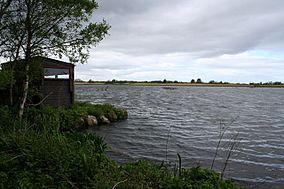Loch Spynie facts for kids
Quick facts for kids Loch Spynie |
|
|---|---|

Birdwatchers' hut on Loch Spynie
|
|
| Location | Moray, Scotland |
| Nearest city | Elgin |
| Area | 0.94 km2 (0.36 sq mi) |
| Established | 1992 |
| Governing body | Joint Nature Conservation Committee |
Loch Spynie is a small lake in Scotland, located between the towns of Elgin and Lossiemouth in Moray. It's near Spynie Palace, which was once home to the bishops of Moray. This loch is a very important place for wildlife. Because of its importance, it is protected as a Ramsar Site. This means it's recognized internationally for its special natural features.
Contents
History of Loch Spynie
Loch Spynie is what's left of a huge wetland area. This wetland once stretched from the current loch all the way to the mouth of the River Lossie. Long ago, many towns along the Moray coast were actually islands in the Moray Firth.
Over many centuries, the connections this area had to the sea filled up with silt. Silt is like fine mud or sand carried by water. Even so, the Laich of Moray, which is a low-lying area, could still be traveled by boat in the Middle Ages.
In the mid-1800s, a special waterway called the Spynie Canal was built. It was designed by a famous engineer named Thomas Telford. The canal was made to drain water from the Laich of Moray. This helped turn the wet land into useful farmland.
Artificial banks were built on the western and northern sides of the loch. The loch itself was kept for hunting wild birds and for fishing. However, hunting birds stopped completely in 1981. Since then, very little fishing has taken place at the loch.
Wildlife at Loch Spynie
Loch Spynie is a naturally eutrophic loch. This means it has a lot of nutrients, which helps many plants grow. The open water is surrounded by large areas of reedbeds. These are wetlands filled with tall grasses called reeds.
The loch is one of the few places in Scotland where you can find alder swamp woodland. It also has unusual water plants, including the slenderleaf pondweed, which is rare in the country.
Birds of Loch Spynie
Loch Spynie is a very important place for birds. Many greylag geese come here to rest, especially during winter. Up to 5% of the entire Iceland population of these geese spend the winter at Loch Spynie.
Many birds also breed here. These include the grey heron, common tern, black-headed gull, water rail, and little grebe. The gulls and terns build their nests on special floating platforms.
In spring and summer, you might see Osprey fishing in the loch. Marsh harriers can also be spotted. Besides greylags, other birds arrive in autumn, like whooper swan, wigeon, teal, goldeneye, and tufted duck. Some of these birds stay for the whole winter.
Other Animals
Loch Spynie is home to many other animals too. You might spot red squirrels and otters. The loch also has common frogs and common toads.
Protection of Loch Spynie
Loch Spynie is recognized as a wetland of international importance under the Ramsar Convention. This is an international agreement to protect important wetlands.
It has also been named a Special Protection Area and a Site of Special Scientific Interest. These are special protections given by the Scottish government. The RSPB (Royal Society for the Protection of Birds) has provided a bird hide and feeders. You can reach these from the car park, making it a great place for birdwatching.
Images for kids
-
1730 military map of the Laich of Moray, showing the undrained Loch Spynie, the Loch of Cotts to the east of the River Lossie, and other freshwater lochs to the west.


